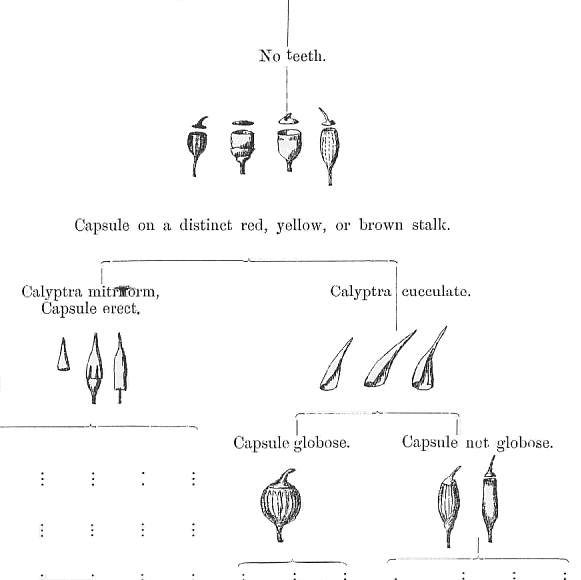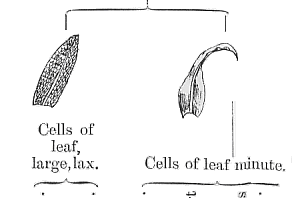Case StudiesBastow's moss chartIn 1887 Richard Bastow published a paper titled "Tasmanian Mosses" in the Papers and Proceedings of the Royal Society of Tasmania. It had been read at a Society meeting in 1886, contained species' descriptions and was accompanied by an illustrated identification key to the genera. That key was presented on a large fold-out sheet, about 110 centimetres long and 60 wide. To use the chart to identify a specimen you start at the top and work your way down. At each point you are asked a question about some feature. Examine the specimen you're trying to identify and look to see if it has the feature in question. Depending on your answer you will be directed to the next question you have to answer. With each question you narrow the range of genera to which your specimen could belong until you are finally left with just one genus. From the photograph of the whole chart you can see that there are many possible pathways through it to lead to the many different genera listed at the chart's base. The rest of this page is taken up by a random selection of extracts from the chart. Here is the first. To get to this point in the chart the immediately preceding question asked whether the mouth of the spore capsule has teeth around its margin. If you answer "no" to that question here is what you'd see next. You are now asked about the calyptra, a protective sheath around the immature spore capsule. If the calyptra in your specimen is cucullate (that is, hood-like in form and with a split on one side) you then have to look at the capsule shape – globose or otherwise. If globose you have three options, if not globose you have four options – as shown by the groups of 3 and 4 dotted lines under the different capsule shape possibilities. The alternative given to cucullate is mitriform – shaped like a bishop's cap or mitre.
At the following point you are asked about a microscopic feature – the nature of the cells that make up the leaves of the moss gametophyte.
The next extract shows the final choice between the genera Andreaea and Phascum and you are asked to look at the way the spore capsule opens. In the former it splits along four vertical lines while in the latter it ruptures irregularly. There are also drawings of a couple of species - Andreaeapetrophila and Phascum gracilentum. This extract has been rotated 90 degrees. What is shown here on the left is actually at the bottom of the chart.
|
![An Australian Government Initiative [logo]](/images/austgovt_brown_90px.gif)





